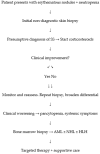Sweet Syndrome-like Dermatosis as a Precursor to Overlapping Hematologic Malignancies: A Case Report and Review
- PMID: 40869568
- PMCID: PMC12387078
- DOI: 10.3390/jcm14165743
Sweet Syndrome-like Dermatosis as a Precursor to Overlapping Hematologic Malignancies: A Case Report and Review
Abstract
Sweet syndrome (SS) is a rare neutrophilic dermatosis often associated with hematologic malignancies, particularly myelodysplastic syndromes (MDSs). We report a case of SS-like dermatosis in a patient with MDS who subsequently developed peripheral T-cell non-Hodgkin lymphoma (NHL). We review the literature on Sweet syndrome to contextualize this atypical presentation Methods: We present a case report of a 77-year-old male with leukopenia and known MDS, admitted for a persistent, infiltrated erythematous eruption. The patient underwent repeated dermatologic assessments, and serial skin and bone marrow biopsies with histopathologic and immunohistochemical analysis. A literature review was also conducted, focusing on SS in association with hematologic malignancies, including T-cell NHL. Results: Initial skin biopsies were inconclusive, and SS was diagnosed clinically based on lesion morphology and a prompt response to corticosteroids, despite the absence of definitive neutrophilic infiltrates. During follow-up, the patient's condition progressed with worsening cytopenias and recurrent febrile episodes. Repeat biopsies eventually confirmed the diagnosis of peripheral T-cell NHL with secondary hemophagocytic lymphohistiocytosis (HLH). Conclusions: This case illustrates the diagnostic uncertainty of SS-like eruptions in hematologic patients when histopathological findings are atypical or absent. Corticosteroid responsiveness may guide early diagnosis.
Keywords: Sweet syndrome; cutaneous manifestations; myelodysplastic syndrome; non-Hodgkin lymphoma.
Conflict of interest statement
The authors declare no conflicts of interest.
Figures






Similar articles
-
Complex Interplay Between Sweet Syndrome and Therapy-Related Myelodysplastic Syndrome After B-Cell Lymphoma Treatment: A Case Report.Am J Case Rep. 2025 Aug 11;26:e949165. doi: 10.12659/AJCR.949165. Am J Case Rep. 2025. PMID: 40785134 Free PMC article.
-
[Classical Sweet syndrome with multiple organ lesions by 18F-FDG PET/CT: A case report].Beijing Da Xue Xue Bao Yi Xue Ban. 2025 Apr 18;57(2):403-407. doi: 10.19723/j.issn.1671-167X.2025.02.030. Beijing Da Xue Xue Bao Yi Xue Ban. 2025. PMID: 40219578 Free PMC article. Chinese.
-
Prescription of Controlled Substances: Benefits and Risks.2025 Jul 6. In: StatPearls [Internet]. Treasure Island (FL): StatPearls Publishing; 2025 Jan–. 2025 Jul 6. In: StatPearls [Internet]. Treasure Island (FL): StatPearls Publishing; 2025 Jan–. PMID: 30726003 Free Books & Documents.
-
Optimisation of chemotherapy and radiotherapy for untreated Hodgkin lymphoma patients with respect to second malignant neoplasms, overall and progression-free survival: individual participant data analysis.Cochrane Database Syst Rev. 2017 Sep 13;9(9):CD008814. doi: 10.1002/14651858.CD008814.pub2. Cochrane Database Syst Rev. 2017. PMID: 28901021 Free PMC article.
-
Initially lymphocytic Sweet's syndrome in male patients with myelodysplasia: a distinguished clinicopathological entity? Case report and systematic review of the literature.Acta Haematol. 2014;132(2):220-5. doi: 10.1159/000357933. Acta Haematol. 2014. PMID: 24714374
References
-
- Merlant M., Lepelletier C., Battistella M., Vignon-Pennamen M.-D., Duriez P., Moguelet P., Brunet-Possenti F., Bagot M., Chasset F., Bouaziz J.D. Acute myeloid leukemia and myelodysplastic syndrome–associated Sweet syndrome: A comparative multicenter retrospective study of 39 patients. J. Am. Acad. Dermatol. 2020;84:838–840. doi: 10.1016/j.jaad.2020.09.089. - DOI - PubMed
-
- Kakaletsis N., Kaiafa G., Savopoulos C., Iliadis F., Perifanis V., Tzalokostas V., Grekou A., Giannouli A., Hatzitolios A.I. Initially Lymphocytic Sweet’s Syndrome in Male Patients with Myelodysplasia: A Distinguished Clinicopathological Entity? Case Report and Systematic Review of the Literature. Acta Haematol. 2014;132:220–225. doi: 10.1159/000357933. - DOI - PubMed
Publication types
LinkOut - more resources
Full Text Sources
Research Materials
Miscellaneous

